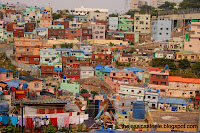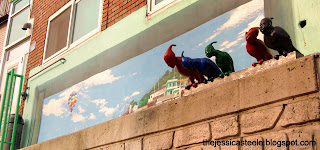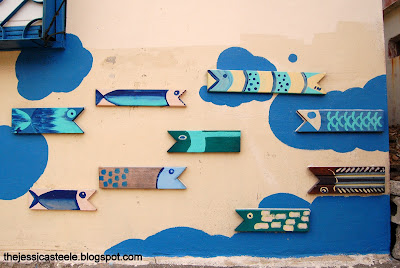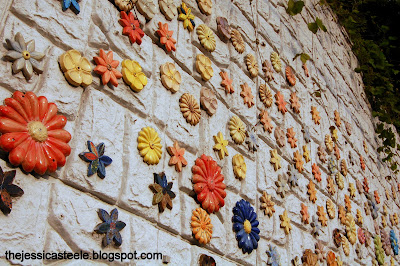I was sitting in Busan one day naively thinking I'd seen it all, when this wonderful city surprised me with something new yet again. At the suggestion of a friend, my boyfriend and I made our way to the Gamcheon Culture Village, a picturesque art-adorned village perched high atop a hill overlooking the city and the sea.
We hopped on the subway early on a mid-week holiday morning, the subway lines bustling with the activity of a day-off from work. We were without seats until just after Busan station when the crown thinned and we were left to our own until our stop at Toesong station. We emerged from the underground, blinking against the now hot daylight, and heading over to the tiny bus shelter to continue on the next leg of our journey. We shared the tight spot with a few older Koreans also seeking shade. An elderly man with silver teeth asked us where we were from. "Canada and New Zealand," we replied and he smiled, satisfied. He had once been to New York he told us. I wish I knew more Korean to ask him how he ended up there. Our little ten-seater mini-bus pulled up then, and then the little bus pulled hard to tote our medley crew up the steep, steep mountain.
Just a few minutes later, that ramshackle bus rumbled to the top. When the bus halted to a stop and looked as though it could no further, we knew we were there! Leaving the bus with residents and fellow tourists, we were struck by how bright it was, and how immediately colourful. The elementary school across the street was glowing, as was the painted brick wall around it. The tourist map beamed at us, hung from a post shaped like a rainbow. We consulted the map, soaking up the promise of art and novelty.
Heading down the street directly opposite the elementary school and our bus stop, we stopped for photos within moments, admiring some trick art on the side of building and some novel sculptures. In our excitement, we passed the Art Shop, a cute little building set just below street-level with a painted roof. We had to return there later to pick up a guide map. The colorfully-illustrated map cost just 1,000 won and doubled as a stamp page for collecting stamps at seven featured art locations. Those stamps earned us a prize of two postcards or a photo each at the end of the day! We collected our prize at The Haneul Maru or Tourist Information and Observatory Center, directly up the steep stairways opposite the Art Shop. Haneul Maru also sells maps as well as souvenirs and admission to art experience programs, and there we also learned the history of the town.
Although the village had remained relatively poor since its war-torn beginnings, in 2007 it was re-conceived as a historic and scenic landmark, undergoing reparations. In 2009 the Dreaming of Machu Picchu in Busan project was undertaken, installing ten artworks by professional artists, some created with the assistance of the residents. In 2010 the Miro Miro project saw the the addition of twelve works, including alley paintings and path markers, tying in neatly with the miro theme, miro meaning "maze" in Korean. These days visitors can see trick art, sculpture, quirky paint jobs like cow-hide-patterned buildings, and even rooms or buildings remodeled around a singular art concept, such as the Book Cafe shaped like a giant coffee mug, or rooms interpreting themes such as "peace" or "darkness".
 You can see the seven featured artworks within an hour, but half the fun is strolling through the village, absorbing the history and the sights. The village is situated in such a way that it overlooks the sea and is bathed in sun from every angle. The ever-present sunshine lights up the multi-coloured block houses in such a way that you believe that you've accidentally wandered into a children's book or a fairy-tale. My boyfriend and I had such fun meandering the sunny streets that we stayed until we crossed off every landmark off of our map, photo-snapping and wandering for nearly six hours!
You can see the seven featured artworks within an hour, but half the fun is strolling through the village, absorbing the history and the sights. The village is situated in such a way that it overlooks the sea and is bathed in sun from every angle. The ever-present sunshine lights up the multi-coloured block houses in such a way that you believe that you've accidentally wandered into a children's book or a fairy-tale. My boyfriend and I had such fun meandering the sunny streets that we stayed until we crossed off every landmark off of our map, photo-snapping and wandering for nearly six hours!
Some notes about visiting:
- The village is relatively quiet despite its status as a tourist attraction and go-to backdrop setting for Korean cinema and photography. As such, some of the locals grow weary of the attention, and understandably so. Please be respectful, and ask to take photos of the locals. They are much more hesitant to have their photo taken than in other areas of Busan.
- Keep to the footpaths, or at least try not to disturb the residents in their homes. The paths are marked with cute little arrows or fishes, so don't be surprised if a local tells you that you are not in the right area and re-directs you! Don't worry too much about getting lost - Up takes you to the top, where you can easily re-establish your bearings, and down leads to the hustle-and-bustle of Busan once again!
- I would also suggest that you dress modestly, Western women in particular, as the majority of the residents are older. I dressed up in a nice sundress that drew some very vocal criticism (and one pat on the back) from the village elderly!
- Finally, if you come across the burial grounds (unnumbered on the map), please be advised that pictures are not allowed, and unfortunately the only signage stating this is in Korean.
To get there, take the red line (Line 1) to Toesong Station (Stop #109), Exit 6. Walk straight until you see the PNUH (Pusan National University Hospital) Cancer Center on your right. Cross to the same side and take the 2 or 2-2 bus from the small bus shelter there. It takes about 10 minutes, disembark at the top with everyone else! Return there when you're ready to head back to busy Busan.
The village is open from 9:00 a.m. until 6:00 p.m. Don't forget your camera or your sunscreen!



















Your best work yet I dare say! Great photos too! All ways a great read, well done ^^
ReplyDeleteWhy, thank you! ♥ This one took the longest of any blog I've written yet, so I appreciate your comments! ^^
DeleteJessica, I am about to visit the village this week or next week, and I saw your blog post. Thank you for posting. Nice post!
ReplyDeleteThank you, Dita! It's so fun! I advise that you also bring a snack or two. There are plenty of cafes, but not much in the way of larger restaurants ^^
Delete